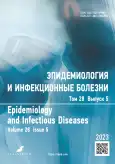Healthcare-associated infections in the constituents of Ural and Siberian Federal Districts: results of monitoring their identification and registration in 2022 and in long-term dynamics
- Authors: Smirnova S.S.1,2, Egorov I.A.1, Stagilskaya Y.S.1, Zhuikov N.N.1
-
Affiliations:
- Federal Scientific Research Institute of Viral Infections “Virome”
- Ural State Medical University
- Issue: Vol 28, No 5 (2023)
- Pages: 296-318
- Section: TECHNICAL REPORTS
- URL: https://ogarev-online.ru/1560-9529/article/view/148248
- DOI: https://doi.org/10.17816/EID562745
- ID: 148248
Cite item
Abstract
Rationale. Monitoring of HAI (health care-associated infections) detection and registration of is one of the key components in the information subsystem of epidemiological surveillance for these infections. Despite a well-established HAI recording system in the Russian Federation as a whole, the constituents of the Ural and Siberian Federal Districts have different approaches to detection of these infections, which is confirmed by the final rating scores of their detection and registration.
Objective. We studied HAI detection and registration in the constituents of the Ural and Siberian Federal Districts for ranking and rating their systems of epidemiological HAI surveillance.
Materials and methods: The data of federal statistical monitoring forms No. 2 "Information on infectious and parasitic diseases" and No. 23-17 "Information on outbreaks of infectious diseases as well as from additional enquiry materials "Information on medical manipulations and cohorts treated" in 2018–2022 submitted by the Rospotrebnadzor offices of the respective Russian Federation constituents compared with the long-term and Russia’s nationwide averages. The quality of HAI registration in the healthcare institutions of the Ural and Siberian Federal Districts was rated using grouping by intensive incidence indicators, and the most significant groups of infections and risk cohorts were selected for analysis.
Results: The results of the HAI detection and registration by the most significant groups of infections and risk cohorts among the patients and healthcare workers were analyzed. The data on the group and outbreak HAI morbidity in the healthcare institutions are presented. The quality of HAI detection and registration in the constituents of the Ural and Siberian Federal Districts was rated, and the subjects were ranked with regard to the activity of their epidemiological surveillance system.
Conclusion: Active detection and registration of HAI cases over several years is typical for the healthcare institutions of Sverdlovsk and Chelyabinsk Oblasts as well as Yamalo-Nenets Autonomous District. Consistently low rating scores of the studied parameters are typical for the healthcare institutions of the Republics of Tyva, Altai and Krasnoyarsk Krai.
Full Text
##article.viewOnOriginalSite##About the authors
Svetlana S. Smirnova
Federal Scientific Research Institute of Viral Infections “Virome”; Ural State Medical University
Email: smirnova_ss69@mail.ru
ORCID iD: 0000-0002-9749-4611
SPIN-code: 3127-4296
https://www.facebook.com/profile.php?id=100006558874957
MD, Cand. Sci. (Med.), Associate Professor
Russian Federation, 23 Letnyaya street, 620030 Yekaterinburg; 3, st. Repina, 620028 EkaterinburgIvan A. Egorov
Federal Scientific Research Institute of Viral Infections “Virome”
Email: egorov_ia@niivirom.ru
ORCID iD: 0000-0002-7153-2827
SPIN-code: 6465-0182
Junior Research Associate
Russian Federation, 23 Letnyaya street, 620030 YekaterinburgYulia S. Stagilskaya
Federal Scientific Research Institute of Viral Infections “Virome”
Email: stagilskaya_ys@niivirom.ru
ORCID iD: 0009-0000-9261-5624
SPIN-code: 2923-4892
врач-эпидемиолог
Russian Federation, 23 Letnyaya street, 620030 YekaterinburgNikolai N. Zhuikov
Federal Scientific Research Institute of Viral Infections “Virome”
Author for correspondence.
Email: zhuykov_nn@niivirom.ru
ORCID iD: 0000-0002-7018-7582
SPIN-code: 2218-5795
Russian Federation, 23 Letnyaya street, 620030 Yekaterinburg
References
- Popova AY, Ezhlova EB, Igonina EP, Melnikova AA, Frolova NV. Supervision over compliance with sanitary-epidemiological legislation in the provision of healthcare in order to ensure its quality and safety. Vestnik Roszdravnadzora. 2016;(1):74–80. (In Russ).
- Smirnova SS, Egorov IA, Golubkova AA. Purulent-septic infections in puerperas. Part 1. Рrevalence, risk factors, epidemiological surveillance (literature review). Journal of microbiology, epidemiology and immunobiology. 2022;99(1):109–125. (In Russ). doi: 10.36233/0372-9311-226
- Saleem Z, Godman B, Hassali MA, et al. Point prevalence surveys of health-care-associated infections: a systematic review. Pathog Glob Health. 2019;113(4):191–205. doi: 10.1080/20477724.2019.1632070
- Cassini A, Plachouras D, Eckmanns T, et al. Burden of Six Healthcare-Associated Infections on European Population Health: Estimating Incidence-Based Disability-Adjusted Life Years through a Population Prevalence-Based Modelling Study. PLoS Med. 2016;13(10):e1002150. doi: 10.1371/journal.pmed.1002150
- Schreiber PW, Sax H, Wolfensberger A, Clack L, Kuster SP; Swissnoso. The preventable proportion of healthcare-associated infections 2005–2016: Systematic review and meta-analysis. Infect Control Hosp Epidemiol. 2018;39(11):1277–1295. doi: 10.1017/ice.2018.183
- Costa AL, Privitera GP, Tulli G, Toccafondi G. Infection Prevention and Control. In: Textbook of Patient Safety and Clinical Risk Management. Cham: Springer; 2020. P:99–116.
- Huang HP, Chen B, Wang HY, He M. The efficacy of daily chlorhexidine bathing for preventing healthcare-associated infections in adult intensive care units. Korean J Intern Med. 2016;31(6): 1159–1170. doi: 10.3904/kjim.2015.240
- Smirnova SS, Vyatkina LG, Egorov IA, Zhuykov NN. Analiz vyyavleniya i registratsii infektsii, svyazannykh s okazaniem meditsinskoi pomoshchi v Ural’skom i Sibirskom federal’nykh okrugakh v 2020 godu: informatsionnyi byulleten. Yekaterinburg: YUNIKA, 2021. (In Russ).
- Platonova TA, Golubkova AA, Tutelyan AV, Smirnova SS. The incidence of COVID-19 medical workers. The issues of biosafety and occupational risk factors. Epidemiology and vaccinal prevention. 2021;20(2):4–11. (In Russ). doi: 10.31631/2073-3046-2021-20-2-4-11
- Smallwood N, Harrex W, Rees M, Willis K, Bennett CM. COVID-19 infection and the broader impacts of the pandemic on healthcare workers. Respirology. 2022;27(6):411–426. doi: 10.1111/resp.14208
- Smirnova SS, Egorov IA, Zhuikov NN, et al. Risks of becoming infected with SARS-COV-2 for medical personnel in a large industrial city during the pandemic: comparative assessment. Health Risk Analysis. 2022;(2):139–150. (In Russ).
Supplementary files










